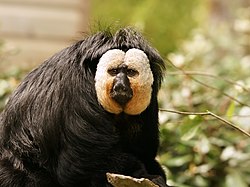Pitheciidae
| Pitheciidae[1] | |
|---|---|

| |
| White-faced saki (Pithecia pithecia) | |

| |
Black-fronted titi (Callicebus nigrifrons)
| |
| Scientific classification | |
| Domain: | Eukaryota |
| Kingdom: | Animalia |
| Phylum: | Chordata |
| Class: | Mammalia |
| Order: | Primates |
| Suborder: | Haplorhini |
| Infraorder: | Simiiformes |
| Parvorder: | Platyrrhini |
| Family: | Pitheciidae Mivart , 1865
|
| Type genus | |
| Pithecia Desmarest, 1804
| |
| Genera (extant) | |
| |
The Pitheciidae ( in the south.
Characteristics
Pitheciids are small to medium-sized monkeys, ranging from 23 cm in head-body length for the smaller titis, to 44–49 cm for the uakaris. They have medium to long fur, in a wide range of colors, often with contrasting patches, especially on the face.
They are
Females give birth to a single young after a gestation period of between four and six months, depending on species. The uakaris and bearded sakis are polygamous, living in groups of 8-30 individuals. Each group has multiple males, which establish a dominance hierarchy amongst themselves. The titis and Pithecia sakis, by contrast, are monogamous and live in much smaller family groups.[2]
Classification
There are 54 currently recognized
- Family Pitheciidae: titis, sakis and uakaris
- Subfamily Callicebinae, titis
- Genus Plecturocebus
- White-eared titi, Plecturocebus donacophilus
- Rio Beni titi, Plecturocebus modestus
- Rio Mayo titi, Plecturocebus oenanthe
- Ollala brothers's titi, Plecturocebus olallae
- White-coated titi, Plecturocebus pallescens
- Urubamba brown titi, Plecturocebus urubambensis
- Baptista Lake titi, Plecturocebus baptista
- Prince Bernhard's titi, Plecturocebus bernhardi
- Brown titi, Plecturocebus brunneus
- Parecis titi, Plecturocebus parecis
- Ashy black titi, Plecturocebus cinerascens
- Hoffmanns's titi, Plecturocebus hoffmannsi
- Red-bellied titi, Plecturocebus moloch
- Vieira's titi, Plecturocebus vieirai
- Milton's titi, Plecturocebus miltoni
- Chestnut-bellied titi, Plecturocebus caligatus
- Coppery titi, Plecturocebus cupreus
- Toppin's titi, Plecturocebus toppini
- Madidi titi, Plecturocebus aureipalatii
- Caquetá titi, Plecturocebus caquetensis
- White-tailed titi, Plecturocebus discolor
- Hershkovitz's titi, Plecturocebus dubius
- Ornate titi, Plecturocebus ornatus
- Stephen Nash's titi, Plecturocebus stephennashi
- Alta Floresta titi, Plecturocebus grovesi
- Genus Callicebus
- Barbara Brown's titi, Callicebus barbarabrownae
- Coimbra Filho's titi, Callicebus coimbrai
- Coastal black-handed titi, Callicebus melanochir
- Black-fronted titi, Callicebus nigrifrons
- Atlantic titi, Callicebus personatus
- Genus †Miocallicebus
- †Miocallicebus villaviejai
- †
- Genus Cheracebus
- Lucifer titi, Cheracebus lucifer
- Black titi, Cheracebus lugens
- Colombian black-handed titi, Cheracebus medemi
- Red-headed titi, Cheracebus regulus
- Collared titi, Cheracebus torquatus
- Genus †Carlocebus
- Genus †Homunculus
- †Homunculus patagonicus
- †
- Genus Plecturocebus
- Subfamily Pitheciinae
- Genus Cacajao, uakaris
- Black-headed uakari, Cacajao melanocephalus
- Bald uakari, Cacajao calvus
- Aracá uakari, Cacajao ayresii[3]
- Neblina uakari, Cacajao hosomi[3]
- Genus †Cebupithecia
- †Cebupithecia sarmientoi
- Genus Chiropotes, bearded sakis
- Black bearded saki, Chiropotes satanas
- Red-backed bearded saki, Chiropotes chiropotes
- Brown-backed bearded saki, Chiropotes israelita
- Uta Hick's bearded saki, Chiropotes utahickae
- White-nosed saki, Chiropotes albinasus
- Genus †Nuciruptor
- †Nuciruptor rubricae
- Genus †Mazzonicebus
- †Mazzonicebus almendrae
- Genus Pithecia, sakis
- Equatorial saki, Pithecia aequatorialis
- buffy saki, Pithecia albicans
- Cazuza's saki, Pithecia cazuzai
- Golden-faced saki, Pithecia chrysocephala
- Hairy saki, Pithecia hirsuta
- Burnished saki, Pithecia inusta
- Gray's bald-faced saki, Pithecia irrorata
- Isabel's saki, Pithecia isabela
- Monk saki, Pithecia monachus
- Miller's saki, Pithecia milleri
- Mittermeier's Tapajós saki, Pithecia mittermeieri (disputed)[6]
- Napo saki, Pithecia napensis
- Pissinatti's saki, Pithecia pissinattii (disputed)[6]
- White-faced saki, Pithecia pithecia
- Rylands' bald-faced saki, Pithecia rylandsi (disputed)[6]
- Vanzolini's bald-faced saki, Pithecia vanzolinii
- Genus †Proteropithecia
- †Proteropithecia neuquenensis
- Genus †Soriacebus
- †Soriacebus ameghinorum
- †Soriacebus adrianae
- †Genus Xenothrix
- †Jamaican monkey, Xenothrix mcgregori
- †Genus Antillothrix
- †Hispaniolan monkey, Antillothrix bernensis
- †Genus Insulacebus
- †Insulacebus toussentiana
- Genus Cacajao, uakaris
- Subfamily
*Newly described species.[3]
†
Silvestro etal 2017 showed the relationship among the extinct and extant pitheciid genera:[5]
| stem Pitheciidae |
| ||||||||||||||||||||||||||||||||||||||||||||||||||||||||||||||||||||||||||||||||||||||||||||||||
References
- ^ OCLC 62265494.
- ^ ISBN 0-87196-871-1.
- ^ S2CID 26561719.
- ^ The Paleobiology Database Pitheciidae entry accessed on 6 April 2010
- ^ bioRxiv 10.1101/178111.
- ^ .
